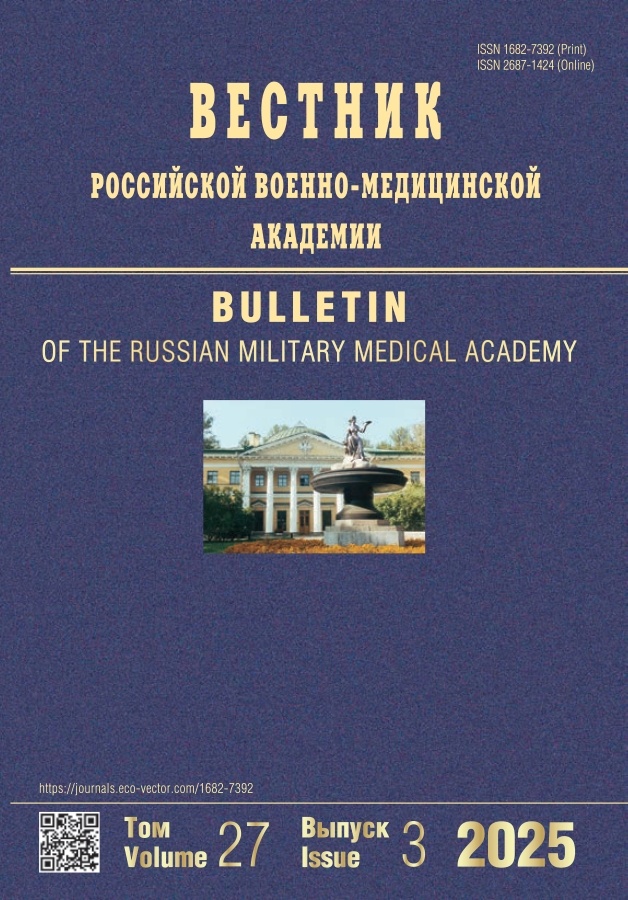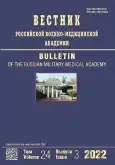Physiological features of development and options for technology for obtaining pluripotent stem cells
- 作者: Moskalev A.V.1, Gumilevskiy B.Y.1, Apchel V.Y.1,2, Tsygan V.N.1
-
隶属关系:
- Military Medical Academy of S.M. Kirov
- A.I. Herzen Russian State Pedagogical University of the Ministry of Education and Science of the Russian Federation
- 期: 卷 24, 编号 3 (2022)
- 页面: 581-592
- 栏目: Review
- URL: https://journals.rcsi.science/1682-7392/article/view/81372
- DOI: https://doi.org/10.17816/brmma81372
- ID: 81372
如何引用文章
详细
Topical issues related to the technology of isolation and mechanisms of development of pluripotent stem cells and their application in medicine are considered. The isolation, as well as the subsequent use of stem cells, still remains an unsolved problem both from a scientific point of view and especially in practical health care. There are three ways to produce pluripotent stem cells. First, they can be obtained in vitro from cell culture of the inner layer of early eggs. These are embryonic stem cells. Second, they can be obtained from somatic cells, as a result of the introduction of a group of genes that induce pluripotency. These are induced pluripotent stem cells. Finally, they can be obtained by transplanting the nucleus of somatic cells into an enucleated secondary egg. The microenvironment of the egg contributes to the reprogramming of the nucleus to a state close to the zygote. Mouse embryonic stem cells have many embryonic markers on their surface: carbohydrate receptors — CD15, alkaline phosphatase, factor 4 like Kruppel, estrogen-bound receptor, transcription factor CP2 like 1, T-box transcription factor and gastrulation homeobox brain 2. Embryonic mouse stem cells differentiate from the internal mass of cells at the stage of preimplantation, epiblast. This is established by comparing gene expression profiles and directly isolating embryonic stem cells from epiblasts of 4.5-day-old fertilized eggs. Embryonic stem cells derived from mouse embryos of later stages of development lose markers of pluripotency. Approximately 3 days after the elimination of the leukemia inhibition factor, the expression of the Oct4 gene leads to the loss of specificity markers by cells of the early embryo. Currently, the reprogramming of pluripotency is an active area of research in which significant technological progress has been made. So, the original gene cocktail consisting of four genes is used: Oct4, Sox2, Klf4 and cMyc. The obtained types of embryonic stem cells of mouse and human, from fertilized blastocysts, induced pluripotent stem cells undoubtedly exist. However, this does not apply to pluripotent stem cells derived from postnatal animals, humans, or from extraembryonic sources such as amniotic fluid or cord blood. Despite the fact that many laboratories are working to obtain stem cells from these objects, unfortunately, there is little reproducibility in this work, and the properties of the resulting cells and even their existence are still the subject of controversy.
作者简介
Alexander Moskalev
Military Medical Academy of S.M. Kirov
编辑信件的主要联系方式.
Email: alexmav195223@yandex.ru
ORCID iD: 0000-0002-3403-3850
SPIN 代码: 8227-2647
Doctor of Medical Sciences, Professor
俄罗斯联邦, Saint PetersburgBoris Gumilevskiy
Military Medical Academy of S.M. Kirov
Email: gumbu@mail.ru
SPIN 代码: 3428-7704
Scopus 作者 ID: 6602391269
Researcher ID: J-1841-2017
Doctor of Medical Sciences, Professor
俄罗斯联邦, Saint PetersburgVasiliy Apchel
Military Medical Academy of S.M. Kirov; A.I. Herzen Russian State Pedagogical University of the Ministry of Education and Science of the Russian Federation
Email: apchelvya@mail.ru
ORCID iD: 0000-0001-7658-4856
SPIN 代码: 4978-0785
Scopus 作者 ID: 6507529350
Researcher ID: Е-8190-2019
Doctor of Medical Sciences, Professor
俄罗斯联邦, Saint Petersburg; Saint PetersburgVasiliy Tsygan
Military Medical Academy of S.M. Kirov
Email: vn-t@mail.ru
ORCID iD: 0000-0003-1199-0911
SPIN 代码: 7215-6206
Scopus 作者 ID: 6603136317
Doctor of Medical Sciences, Professor
俄罗斯联邦, Saint Petersburg参考
- Moskalev AV, Sboichakov VB, Rudoi AS. Obshchaya immunologiya s osnovami klinicheskoi immunologii. Moscow: GEOTAR-Media, 2015. 351 p. (In Russ.).
- Moskalev AV, Gumilevskii BYu, Sboichakov VB. Meditsinskaya immunologiya s voprosami immunnoi nedostatochnosti i osnovami klinicheskoi immunologii. Saint Petersburg: VMA, 2019. 327 p. (In Russ.).
- Yarilin AA. Immunologiya. Moscow: GEOTAR-Media, 2010. 957 p. (In Russ.).
- lson K, De Nardin E. Contemporary clinical immunology and serology. New Jersey: Upper Saddle River, 2013. 439 p.
- Duggal G, Warrier S, Ghimire S, et al. Alternative Routes to Induce Naïve Pluripotency in Human Embryonic Stem Cells. Stem Cells. 2015;33(9):2686–2698. doi: 10.1002/stem.2071
- González F, Huangfu D. Mechanisms underlying the formation of induced pluripotent stem cells. Wiley Interdiscip Rev Dev Biol. 2016;5(1):39–65. doi: 10.1002/wdev.206
- Nichols J, Smith A. The origin and identity of embryonic stem cells. Development. 2011;138(1):3–8. doi: 10.1242/dev.050831
- De Los Angeles A, Ferrari F, Xi R, et al. Hallmarks of pluripotency. Nature. 2015;525(7570):469–478. doi: 10.1038/nature15515
- Dunn SJ, Martello G, Yordanov B, et al. Defining an essential transcription factor program for naïve pluripotency. Science. 2014;344(6188):1156–1160. doi: 10.1126/science.1248882
- Augui S, Nora EP, Heard E. Regulation of X-chromosome inactivation by the X-inactivation centre. Nat Rev Genet. 2011;12(6):429–442. doi: 10.1038/nrg2987
- Rossant J, Tam PPL. New Insights into Early Human Development: Lessons for Stem Cell Derivation and Differentiation. Cell Stem Cell. 2017;20(1):18–28. doi: 10.1016/j.stem.2016.12.004
- Abad M, Mosteiro L, Pantoja C, et al. Reprogramming in vivo produces teratomas and iPS cells with totipotency features. Nature. 2013;502:340–345. doi: 10.1038/nature12586
- Bulic-Jakus F, Katusic Bojanac A, Juric-Lekic G, et al. Teratoma: from spontaneous tumors to the pluripotency/malignancy assay. Wiley Interdiscip Rev Dev Biol. 2016;5(2):186–209. doi: 10.1002/wdev.219
- Silva M, Daheron L, Hurley H, et al. Generating iPSCs: translating cell reprogramming science into scalable and robust biomanufacturing strategies. Cell Stem Cell. 2015;16(1):13–17. doi: 10.1016/j.stem.2014.12.013
- Sohni A, Verfaillie CM. Multipotent adult progenitor cells. Best Pract Res Clin Haematol. 2011;24(1):3–11. doi: 10.1016/j.beha.2011.01.006
- Stadtfeld M, Hochedlinger K. Induced pluripotency: history, mechanisms, and applications. Genes Dev. 2010;24(20):2239–2263. doi: 10.1101/gad.1963910
- Tamm C, Pijuan Galitó S, Annerén C. A comparative study of protocols for mouse embryonic stem cell culturing. PLoS One. 2013;8(12):e81156. doi: 10.1371/journal.pone.0081156
- Ma H, Morey R, O’Neil RC, et al. Abnormalities in human pluripotent cells due to reprogramming mechanisms. Nature. 2014;511(7508):177–183. doi: 10.1038/nature13551
- Tachibana M, Amato P, Sparman M, et al. Human embryonic stem cells derived by somatic cell nuclear transfer. Cell. 2013;153(6): 1228–1238. doi: 10.1016/j.cell.2013.05.006
- McDonald JI, Celik H, Rois LE, et al. Reprogrammable CRISPR/Cas9-based system for inducing site-specific DNA methylation. Biol Open. 2016;5(6):866–874. doi: 10.1242/bio.019067
- Abbas AK, Lichtman AN, Pillai S. Cellular and Molecular Immunology. 9-th edition. Philadelphia, Pennsylvania: W.B. Saunders Company, 2018. 565 p.
- Sternberg SH, Redding S, Jinek M, et al. DNA interrogation by the CRISPR RNA-guided endonuclease Cas9. Nature. 2014;507(7490): 62–67. doi: 10.1038/nature13011
- Thakore PI, D'Ippolito AM, Song L, et al. Highly specific epigenome editing by CRISPR-Cas9 repressors for silencing of distal regulatory elements. Nat Methods. 2015;12(12):1143–1149. doi: 10.1038/nmeth.3630
- Gjorevski N, Ranga A, Lutolf MP. Bioengineering approaches to guide stem cell-based organogenesis. Development. 2014;141(9):1794–1804. doi: 10.1242/dev.101048
- Kang H-W, Lee SJ, Ko IK, et al. A 3D bioprinting system to produce human-scale tissue constructs with structural integrity. Nat Biotechnol. 2016;34(3):312–319. doi: 10.1038/nbt.3413
- Yamaguchi T, Sato H, Kato-Itoh M, et al. Interspecies organogenesis generates autologous functional islets. Nature. 2017;542(7640):191–196. doi: 10.1038/nature21070
- Richardson BE, Lehmann R. Mechanisms guiding primordial germ cell migration: strategies from different organisms. Nat Rev Mol Cell Biol. 2010;11(1):37–49. doi: 10.1038/nrm2815
- Hilton IB, D'Ippolito AM, Vockley CM, et al. Epigenome editing by a CRISPR-Cas9-based acetyltransferase activates genes from promoters and enhancers. Nat Biotechnol. 2015;33(5):510–517. doi: 10.1038/nbt.3199
- Geraghty RJ, Capes-Davis A, Davis JM, et al. Cancer Research UK. Guidelines for the use of cell lines in biomedical research. Br J Cancer. 2014;111(6):1021–1046. doi: 10.1038/bjc.2014.166
- Liu N, Zang R, Yang ST, Li Y. Stem cell engineering in bioreactors for large-scale bioprocessing. Eng Life Sci. 2014;14:4–15. doi: 10.1002/elsc.201300013
- Sasaki K, Nakamura T, Okamoto I, et al. The Germ Cell Fate of Cynomolgus Monkeys Is Specified in the Nascent Amnion. Dev Cell. 2016;39(2):169–185. doi: 10.1016/j.devcel.2016.09.007
- Slack JMW. The science of stem cells. John Wiley and Sons Inc., 2018. 248 p. doi: 10.1002/9781119235293
- Sasai Y. Next-generation regenerative medicine: organogenesis from stem cells in 3D culture. Cell Stem Cell. 2013;12(5):520–530. doi: 10.1016/j.stem.2013.04.009
- Wu Y, Chen L, Scott PG, Tredget E.E. Mesenchymal stem cells enhance wound healing through differentiation and angiogenesis. Stem Cells. 2007;25(10):2648–2659. doi: 10.1634/stemcells.2007-0226
- Gilbert LA, Larson MH, Morsut L, et al. CRISPR-mediated modular RNA-guided regulation of transcription in eukaryotes. Cell. 2013;154(2):442–451. doi: 10.1016/j.cell.2013.06.044
- Zetsche B, Gootenberg JS, Abudayyeh OO, et al. Cpf1 is a single RNA-guided endonuclease of a class 2 CRISPR-Cas system. Cell. 2015;163(3):759–771. doi: 10.1016/j.cell.2015.09.038
- Zia S, Mozafari M, Natasha G, et al. Hearts beating through decellularized scaffolds: whole-organ engineering for cardiac regeneration and transplantation. Crit Rev Biotechnol. 2016;36(4): 705–715. doi: 10.3109/07388551.2015.1007495
补充文件








